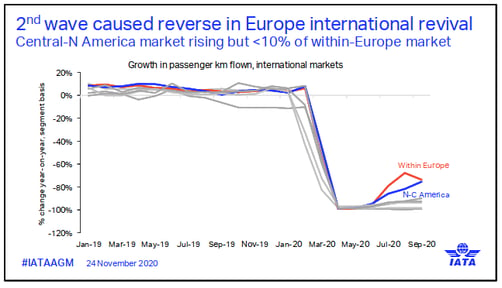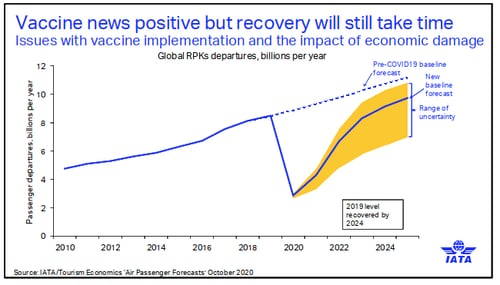Border Bottlenecks: How to Streamline Traveller Flow
In 2019, airport traffic increased by 4%, with twenty-five of Europe’s thirty busiest airports experiencing a surge in air traveller flows. The COVID-19 pandemic has forced a shift in expectations for the continent’s carriers.
The extensive second wave of COVID-19 in Europe prevented a hoped-for revival. According to IATA’s Outlook for Air Transport and the Airline Industry, renewed economic lockdown and the slow rollout of vaccines across Europe have caused an actual reversal in international travel.

[Image source: Outlook for Air Transport and the Airline Industry - IATA]
However, this effect is likely to be temporary. Assuming the successful distribution and deployment of vaccines by the latter part of 2021, travel rates may rise substantially in 2022. IATA projects a return to 2019 levels by 2024. The European travel industry will undoubtedly regain strength in years to come.

[Image source: Outlook for Air Transport and the Airline Industry - IATA]
Border Bottlenecks: How to Streamline the Flow of Travellers
Much of the resurgence in travel will occur in the 26 countries of Europe’s Schengen Area - the region whose members have abolished their internal borders, allowing holders of a uniform Schengen visa-free and unrestricted movement.
Different border crossings present unique challenges and require custom-tailored solutions. The key to optimising traveller flow systems is to identify and remove “border bottlenecks” - the obstacles creating barriers to a steady flow of travellers at every stage of a border crossing.
Traveller flow analysis is a critical requirement in achieving this. In addition to an end-to-end consideration of the security and safety standards relevant to each stage of the movement, traveller analytics enable border control authorities to assess traveller behaviours and identify potential bottlenecks before they can occur.
Challenges and Opportunities for Smart Border Implementation
Smart border control requires systems and protocols in line with the new EU directives. While maintaining high-level standards of security and meeting anticipated demands in terms of traveller volumes, these systems must be capable of addressing additional border control checks and prolonged waiting times. They must also communicate clear instructions to travellers.
Border control authorities greatly benefit from partnering with a technology provider with the infrastructure and proven track record to ensure a solution that includes all the relevant devices and protocols needed to be compliant with the current and upcoming rules. They’ll also need to adapt current facilities and infrastructure and invest in change management and personnel training for the usage of the new systems.
In a successful partnership for EES implementation with the Finnish Border Guard (RAJA), we defined the concept of complete interoperability between the existing border control infrastructure and the new architecture of the solution. This will guarantee compliance with Smart Borders standards and the Schengen Borders Code.
European Union Entry/Exit System (EES)
The Entry/ Exit-System (EES) is a Europe-wide IT framework that will provide the electronic infrastructure used to collect and process the information of Third Country Nationals travelling between the borders of the EU Schengen zone. Mandatory enforcement of the EES in 2022 means that border control agencies and the EU Commission will have to consider how they can improve the movements of EU and non-EU travellers across air, land, and sea.
Operating at arrival and departure points, the Schengen Entry / Exit System uses digital stamps and systematic biometric data collection for facial and fingerprint recognition, to create a real-time database of travellers. Successful implementation relies on the infrastructure and provider know-how to enable multi-directional data transactions, this allows raw information to be transformed into actionable intelligence.
While technology can increase traveller flow efficiency, reliability and security, member states must also consider the practical challenges of implementing new processes, developing innovative technologies, and overcoming the complexity of integrating machine-operated systems into national security measures.
The EES project for the Finnish Border Guard (RAJA) was provided with last-generation hardware for pre-enrolment, and automated and manual border crossing, sustained by our "Privacy by Design" certified Seamless Journey Platform. This empowered RAJA with an end-to-end solution that is human-centred, including automatic and assisted capture of regulatory information, to process and control all required data while guaranteeing GDPR compliance at every step of the journey.
The Power of Pre-Arrival Information
Unpredictable traffic volumes may lead to border bottlenecks if an agency is unable to deploy sufficient personnel or invest in the necessary infrastructure to process travellers. For air travel, pre-arrival information can improve traveller familiarity with new systems and reduce delays, while promoting a proactive approach to border management.
Successful implementation of the Entry/Exit system provides human operators with enriched passenger information and gives border control institutions an opportunity to optimise their facilities and infrastructure. Data collection and analysis empower border control agencies with actionable insights, and the means to better predict resource allocation.
For our EES implementation in Finland, pre-COVID statistical data was used to break down expected peak hours and volumes of EU/non-EU traveller types entering and leaving the airport. By completing extensive journey mapping and flow modelling, we covered every possible use case and scenario to ensure a smooth sustainable and successful implementation.
Designing for Ergonomic Transit & Effective Communication
Ergonomic transit revolves around the optimal usage of space and physical resources and clear and purposeful communication.
At the physical level, design for ergonomic transit requires the creation of architectural spaces that guide traveller flow through gates and routes, through the intelligent and harmonious use of building systems that are “in tune” with human behaviours.
Signs and information systems for communication are an integral part of this. To avoid bottlenecks, clear and intuitive signage, in various languages, helps educate or direct travellers. Technology can also play an important role, with the deployment of specific apps and avatars on gates and totems, plus the use of data analytics to build intelligent queue management systems.
For Europe’s first Smart Borders implementation at Helsinki Airport, Vision-Box developed an avatar-based technology that interacts with the passenger and mimics their movements, at the ABC eGate. With diversity and inclusion in mind, the customised avatar was a modified version of the Finnish Border Guard teddy bear emblem – which also contributes to a child-centred experience in one of few countries that allow children to go through gates.
Traveller Flow Analysis in Action
Since the EU Smart Borders programme is still in its early stages, there are very few working instances of successful systems that optimise the identification and flow of travellers, establishing trusted biometric identity enrolment, verification and authentication processes.
Vision-Box is a trusted biometric Automated Border Control Systems and integrated electronic Identity management platform provider. We were the first company in Europe to successfully implement a Smart Borders solution, with our EES project at Helsinki Airport, Finland.
Finland is one of Europe’s most significant entry points with an extremely high migratory flux due to the existence of various agreements between countries. As the culmination of a decade-long partnership with the Finnish Border Guard, we have successfully implemented Europe’s first EES project.
Traveller flow analysis is central to the success of this project. Data interpretation is a key success factor and provides a vital feedback loop in Vision-Box’s partnership with the Finnish Border Guard, which has helped to modernise and expand their existing border control infrastructure and increase operational efficiency at Helsinki Airport.